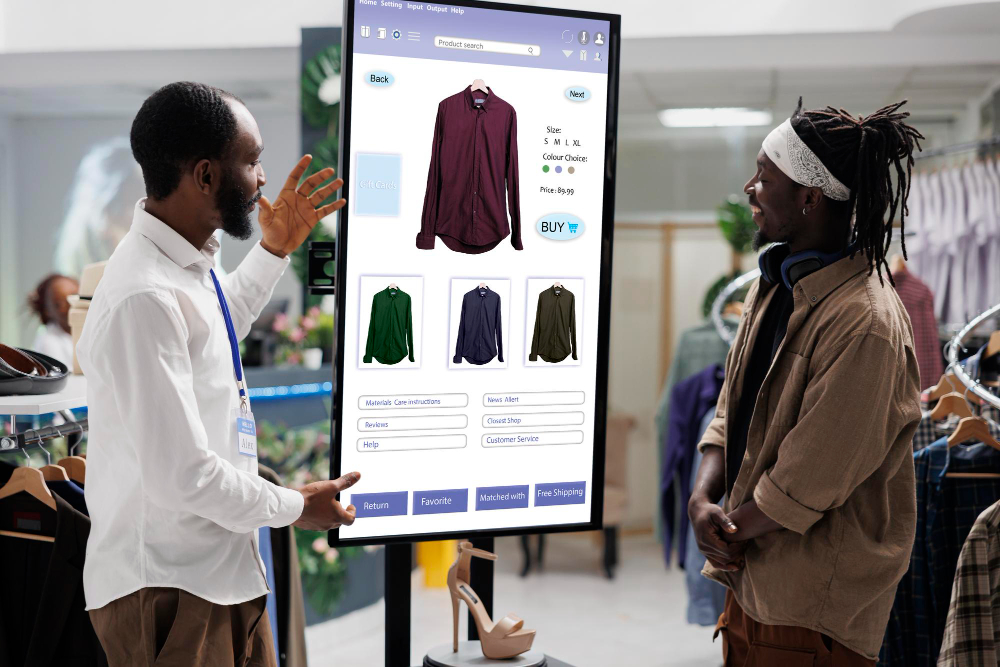Have you ever wondered why some stores leave a lasting impression while others fade from memory? In today’s retail landscape, creating memorable shopping experiences goes far beyond just offering quality products and competitive prices.
Customer experience has become the new battleground for retailers, with personalization and seamless integration of digital and physical touchpoints becoming essential elements for success.
By leveraging data-driven insights, innovative omnichannel strategies, and the perfect blend of AI technology with a human touch, retailers can transform their stores into destinations that keep customers coming back for more.
Personalizing Customer Interactions with Data-Driven Insights
Photo by ASphotofamily on Freepik
Modern shoppers demand personalized experiences, with 71% of customers expecting customized interactions during their shopping journey.
This shift in consumer behavior has created substantial opportunities for businesses that invest in personalization, as 80% of buyers choose to purchase from brands that deliver individualized experiences.
Smart retailers are now using data analytics and customer insights to create meaningful connections that boost loyalty and sales.
Physical stores have found creative ways to blend digital insights with tangible elements. Using an eye-catching custom business signs helps create an inviting atmosphere that resonates with your brand identity while making customers feel welcome.
These personalized touches combine with data-driven strategies to deliver exceptional experiences that keep shoppers coming back.
Here are key ways to implement personalization effectively in your retail space:
- Analyze purchase history and browsing patterns to provide relevant product recommendations
- Create targeted email campaigns based on customer segments and preferences
- Use mobile apps to deliver real-time, location-based offers while customers shop
- Train staff to access customer profiles and provide informed, personalized service
- Design store layouts and displays that adapt to local customer demographics
Smart retailers are taking personalization beyond basic name recognition in emails. They’re using artificial intelligence to predict customer needs and preferences, allowing them to stock inventory that matches local demand.
This data-backed approach helps create shopping experiences that feel custom-made for each visitor while improving operational efficiency.
The most successful stores combine digital innovations with human touch points. Your staff can use customer data to start meaningful conversations, offer relevant suggestions, and solve problems quickly.
This blend of technology and personal connection creates memorable experiences that transform casual shoppers into loyal brand advocates.
| Pro-Tip: Incorporate in-store personalization by setting up tailored product displays or interactive kiosks that suggest items based on customer preferences, creating a seamless and engaging shopping experience. |
Innovative Omnichannel Strategies for Enhanced Engagement
Modern retail success hinges on effective omnichannel integration, with customers expecting consistent experiences across all platforms.
Brands that implement strong omnichannel strategies have witnessed engagement rates soar by 250% higher compared to traditional single-channel approaches.
This significant boost in customer interaction demonstrates how vital it is for retailers to break down barriers between online and offline shopping experiences.
Physical stores are transforming into digital hubs where customers can seamlessly switch between in-person and online interactions. Smart retailers are integrating convenient wall mount solutions to create interactive displays and self-service stations, making technology an integral part of the shopping journey.
Key Ways Retailers are Creating Unified Shopping Experiences Across Channels
The integration of digital tools in physical stores has become increasingly important, with shoppers starting their buying journey online before making in-store purchases.
This shift in consumer behavior requires retailers to create fluid transitions between digital and physical spaces, ensuring customers can move effortlessly between channels during their shopping journey.
- Implementing real-time inventory visibility across online and in-store platforms, allowing customers to check product availability before visiting physical locations
- Creating mobile apps that function as personal shopping assistants, offering product recommendations and store navigation
- Setting up digital kiosks for easy product browsing, price checking, and order placement
- Offering click-and-collect services that blend online convenience with in-store pickup
- Using customer data to personalize experiences across all touchpoints
Smart retailers are leveraging customer data from multiple touchpoints to create personalized experiences that resonate with individual preferences.
By tracking customer interactions across channels, stores can deliver targeted promotions, product recommendations, and customized services that drive engagement and boost sales.
The key lies in maintaining consistency while adapting to each customer’s preferred method of interaction.
| Why This Matters: Seamless omnichannel experiences are no longer a luxury but a necessity, as modern consumers expect frictionless transitions between online and offline shopping. Retailers that successfully integrate digital and physical interactions stand to boost customer engagement, increase brand loyalty, and drive higher sales. |
Integrating AI and Human Touch for a Transformed Experience
Image by Freepik
AI-powered customer interactions are set to reach 95% by 2025, marking a significant shift in how stores connect with their customers.
This transformation is already visible in retail spaces where smart technology merges with traditional shopping methods to create smooth, personalized experiences.
The current retail landscape shows that only 38 percent of shoppers feel truly understood by store employees, highlighting the need for better engagement strategies.
The blend of artificial intelligence and human interaction creates opportunities for stores to enhance their customer service while maintaining personal connections. Visual search capabilities and AI-driven recommendations are transforming how customers find products, while smart analytics help staff provide more informed assistance.
Ways to Effectively Combine AI Technology with Human Elements
The success of this integration relies heavily on maintaining data security and customer privacy.
Stores must establish clear protocols for handling customer information while using AI tools to enhance the shopping experience. Staff training becomes essential to help employees work alongside AI systems effectively.
- Implement AI-powered chatbots for basic inquiries while keeping human staff available for complex issues
- Use predictive analytics to anticipate customer needs and guide staff interactions
- Deploy visual search technology to improve product discovery and increase foot traffic
- Utilize AI for inventory management while maintaining personal shopping assistance
- Create personalized marketing campaigns based on AI insights while ensuring human oversight
The future of retail lies in creating meaningful connections through technology. Stores that successfully blend AI capabilities with human empathy will stand out by offering both efficiency and genuine customer care.
This combination helps build lasting relationships while improving operational effectiveness and service quality.
Transform Your Store
In today’s retail landscape, creating exceptional customer experiences has become the cornerstone of success, with data showing that personalized interactions significantly impact buying decisions and brand loyalty.
This comprehensive approach to retail transformation combines the power of data analytics, omnichannel integration, and AI technology while maintaining the irreplaceable human touch that customers value.
By implementing these strategies thoughtfully and consistently, retailers can create memorable shopping experiences that not only meet but exceed customer expectations, turning casual shoppers into passionate brand advocates who keep coming back for more.



